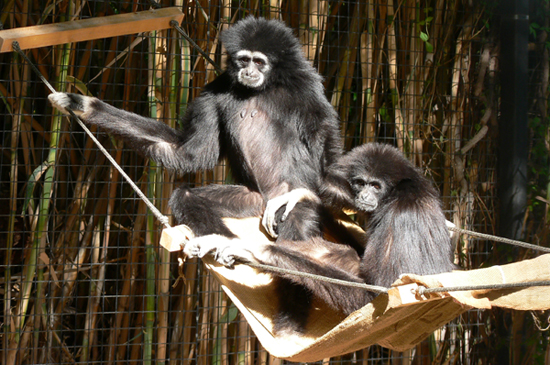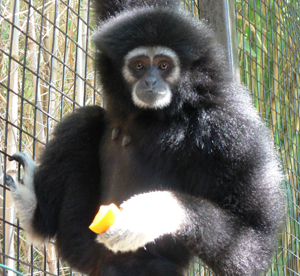Have a “Brew at the Zoo” & Help the Apes, Too

“Brew at the Zoo” will raise funds to move the white-handed gibbons to a new habitat.
photo courtesy Reid Park Zoo
This ain’t any kind of monkey business, oh no. But come Saturday, June 14 at 6 p.m., the Reid Park Zoo opens to local party animals and other 21-and-over friends for a fundraising gala aimed at helping the zoo’s white-handed gibbons move to a new enclosure.
“Brew at the Zoo: Ales for Apes” is the second annual event, partnering the Reid Park Zoological Society (the non-profit entity whose sole mission is to support the city-owned attraction) with Craft Tucson, to raise funds for a site-specific project on the zoo’s 24-acre property. Last year’s sold-out event saw 1200 visitors and served to help welcome grizzly bears Finley and Ronan to Tucson. According to Reid Park Zoological Society’s Events Director Gail Brown, the event raised enough money to pay for the educational components of the grizzly exhibit. This year, Brown says they are expecting a slightly higher turnout for the event at about 1500 participants—with a goal to raise about $25,000—though this is only a portion of what the entire relocation project will cost.
The three gibbons currently on display at Reid Park are a single nuclear family made up of a father named Billy, a mother affectionately called Moms, and their 16-year-old daughter, Lilith—a family structure which Zoo Director Jason Jacobs says is closer to that of human beings than any other species. The apes currently occupy a cage-like enclosure near the entrance to the zoo which Jacobs (formerly of the Los Angeles Zoo) says is ready to come down to make way for something more modern and aesthetically pleasing. The plan is to modify the nearby sun bear enclosure with a mesh canopy and move the gibbons in there.
Jacobs explains that Dresena, the sun bear who currently lives in the gibbons’ future home, is elderly at 35-years-old and prefers to spend most of her time in the indoor section of her habitat—complete with a swamp cooler and regular visits from peanut-wielding backstage tourists. “She doesn’t go on exhibit unless she chooses to,” says Jacobs, and those times are increasingly far in-between, leaving zoo personnel thinking about retiring her from public viewing altogether.
Vivian VanPeenan, the zoo’s educational curator, points out that Billy and Moms are also approaching their golden years; both animals are now well into their forties. Having produced multiple offspring, the pair is now officially out of the national Association of Zoos and Aquariums breeding program, but that does not mean they are any less important to the zoo, its staff, or visitors.
“We like to tell the story (of animals as they age),” says VanPeenan, “we don’t hide it, we don’t put it out of view, but we make it part of our story—how our small community zoo is leading the way in whole-life care for our animals.” She says that it is important for the zoo to serve as an example of “how important it is that when you commit to an animal, whether as a pet or at a zoo, that you are committing to that animal for life.”

Reid Park Zoo’s white-handed gibbons are slated for a new habitat.
photo courtesy Reid Park Zoo
The gibbons on display at Reid Park, though, in no way show their ages. Trying to distinguish parent from offspring is hard to do without a personal introduction (hint: Moms is the one without the white ring around her face), so it’s no surprise that the only ape species on display at the zoo—with their tendency to swing energetically around their enclosure and propensity for singing in the morning—is a visitor favorite. Jacobs says the gibbons are “the best acrobats in the animal kingdom, bar none. Not to demean them in any way,” he adds, “but they are very entertaining.”
Guests interested in helping the gibbons transition to their new homes can buy a ticket to the Brew at the Zoo event online. Attendees can enjoy live music from two bands, eat pub-style food, and sample beers from the 15 unique microbreweries that will be present. Since all of the money raised at the event will go directly into the budget for the gibbon project, VanPeenan points out that “Brew at the Zoo” is a great way for zoo supporters to see their dollars at work on a specific project rather than simply giving to the general fund.
Though the event marks only the first step toward reestablishing both the gibbons and the sun bear in their newly modified habitats, Jacobs envisions other modifications to the exhibit down the line including the addition of an overhead walkway to increase the potential for a close-up encounter. He says the new enclosure will mean easier viewing for the public and more opportunity for interaction with the apes without their current susceptibility to dietary infractions. “For better or worse,” says Jacobs, “our gibbons have learned to beg for food.”
All of these things, according to Jacobs, add up to one thing—happier primates. And that means happier visitors and zoo employees as well—just as long as no one hears you call them monkeys.
Tickets to the June 14 event range in price from $20-$65. The event runs from 6 p.m.-9:30 p.m. For more information, including tickets and room discounts at the nearby Double Tree Resort, visit ReidParkZoo.org.
Category: Community, Events, FOOD & DRINK, Nature




